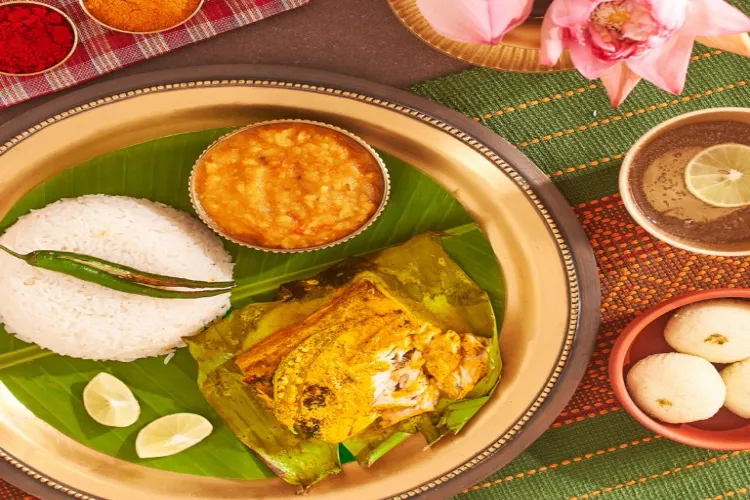.webp)
Sumana Mukherjee / New Delhi
East Bengal which is today’s Bangladesh has always been famous for its culinary culture. People of the land had inherited the unmatched excellence of cooking delectable dishes that produced a sense of satisfaction. As such the undivided Bengal comprising today's West Bengal and Bangladesh is known for its variety of dishes made with fish.
Bengal was the home to the nation’s most powerful thinkers, protestors, and campaigners during the British period. The land always played one of the most impactful roles during India’s extended struggle for freedom. India’s long-awaited freedom came with the merciless price of partition and along with Punjab, Bengal was also destined to face the tragedy of partition.
The state which was enriched with cultural inheritance turned out to be one of the worst sufferers when East Bengal - Purbo Bongo for Bengali speakers - became Pakistan due to its majority Muslim population character and West Bengal or Poschim Bongo with a Hindu majority remained with India.
Bengal was partitioned but the tragedy could never part people from their traditions. As luck would have been if, lakhs of people who were displaced in the orgy of partition violence and shifted to the other Bengal left their houses or lands, yet they carried the inheritance of thoughts and the tradition of taste.
Purbo Bongo’s iconic Sorshe Ilish Bhapa (steamed Hilsa with mustard gravy) is the epitome of culinary finesse. The most amazing fact is there are more than 100 types of recipes of Hilsa mostly found in Bangladesh. Later on, it became extremely popular in West Bengal.
.webp)
Soresh Ilish Bhapa
In the communal frenzy that accompanied the partition of India, Hindus were displaced from Purbo Bongo. They came to India with bare hands and broken hearts and yet after some time decided to give it a desperate try to get back to their roots. It was hard for them to accept homelessness and the tragedy of becoming refugees. They tried to mingle with the residents of West Bengal with the help of traditional food.
Perhaps it was the only way to get back to their good old days and fortunately, people from West Bengal had a cordial approach and they started adapting East Bengal’s nostalgic recipes like Podmaparer Mangsho (Goalondo steamer Curry). Chital Muithya (Fish kabab) or Kochu pata Chingri (shrimp cooked in Colocasia leaves).
It was a watershed period in the history of Bengal when two different cultural inheritances got mixed up and created a new horizon. Bengal became West Bengal where the East met the West. It was the acceptance and assistance from the People of West Bengal that the displaced people could find their homeland once again.
People who belonged to West Bengal were no less in cookery. They started sharing their traditional cooking expertise with East Bengal wholeheartedly. It was a kind of social gesture and sense of gratitude due to their same root of origin. West Bengal is famous for both vegetarian and non-vegetarian dishes. Shukto (mixed vegetable dish) is one of the most awesome dishes that Bengalis love to relish. Sona Moong Daal (Yellow Moong Curry), Aloo bhaja (Fried Potato), Begun Bhaja (fried Brinjal), and Aloo Posto are some of the most famous dishes in West Bengal.
People from East Bengal had fallen in love with some of the West Bengal recipes like Bhetki Paturi (steamed Bhetki fish), Rui Macherkalia, (Rohu Fish curry), Katla roast (Roasted Katlafish) and these are absolutely to name a few amongst celebrated fish items of west Bengal.

Bhetki Paturi
The nostalgic spell of the ancestral home could never be forgotten but it was the bonding of culture and traditional food that could heal the bleeding wounds of the ruthless partition to some extent. People from both the Portions of Bengal had a fetish for food and that truly helped to recreate the history of Bengal once again. Bengal was reborn as West Bengal where people struggled so hard to keep their traditions alive. The charm of cooking helped them to recreate the moments of past days.
Bengal’s obsession with sweets is widely known. Purbo Bongo was the pioneer in that field too. Bengal’s delicious Patishapta, Puli-Payesh originated in East Bengal. Choshir payesh is a semolina and milk-based mouth-watering dessert. Narkol Nadu (Coconut Laddoo), and Moya are some of the traditional sweets that came from the East. World-famous Rosogolla, Sandesh, and Mishti Doi (Sweet Curd) originated in West Bengal, mainly in Kolkata.
ALSO READ: Rampuri Kebab is a cut above other kebabs found in India
Gradually when the East and West Bengal blended, healthy competition started between the two. So food is not only for the taste buds but food is to revisit our rich past and to carry on with the saga of tradition which is timeless.
